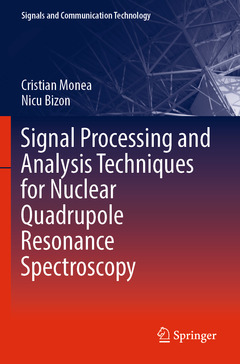Description
Signal Processing and Analysis Techniques for Nuclear Quadrupole Resonance Spectroscopy, 1st ed. 2022
Signals and Communication Technology Series
Authors: Monea Cristian, Bizon Nicu
Language: English
Subject for Signal Processing and Analysis Techniques for Nuclear...:
Publication date: 10-2022
175 p. · 15.5x23.5 cm · Paperback
Publication date: 10-2021
175 p. · 15.5x23.5 cm · Hardback
Description
/li>Contents
/li>Biography
/li>Comment
/li>
This book is about improving prohibited substances detection using the nuclear quadrupole resonance (NQR) technique at security checkpoints. The book proposes multiple signal processing and analysis techniques for improving detection of dangerous or contraband substances, such as explosives, narcotics, or toxic substances. Also, several hardware solutions are described and implemented in a custom-designed NQR spectrometer. A new approach to NQR signal detection is introduced using artificial intelligence/deep learning techniques. The book will be useful for for researchers and practitioners in the areas of electrical engineering, signal processing and analysis, applied spectroscopy, as well as for security or laboratory equipment manufacturers.
Reviews current nuclear quadrople resonance (NQR) techniques
Introduces new techniques
Analyses the subject across disciplines - from electrical engineering, signal processing to AI optimization

